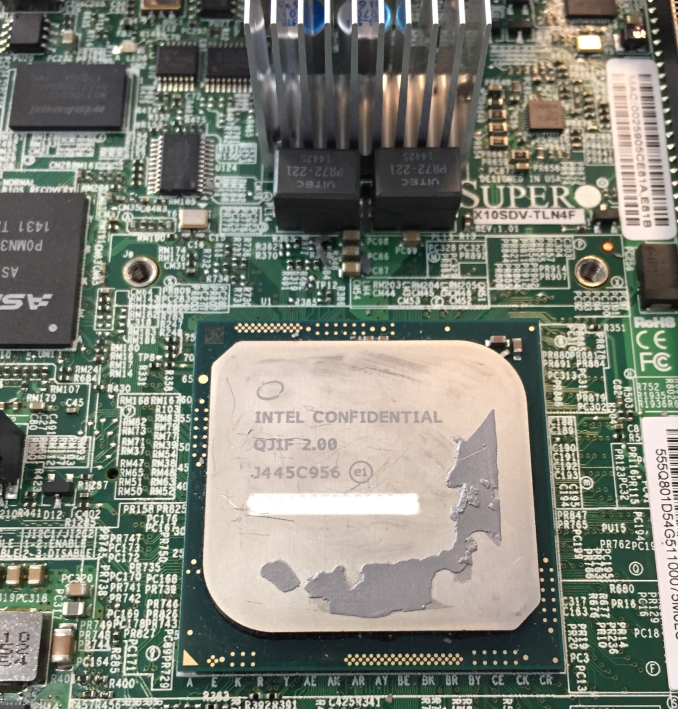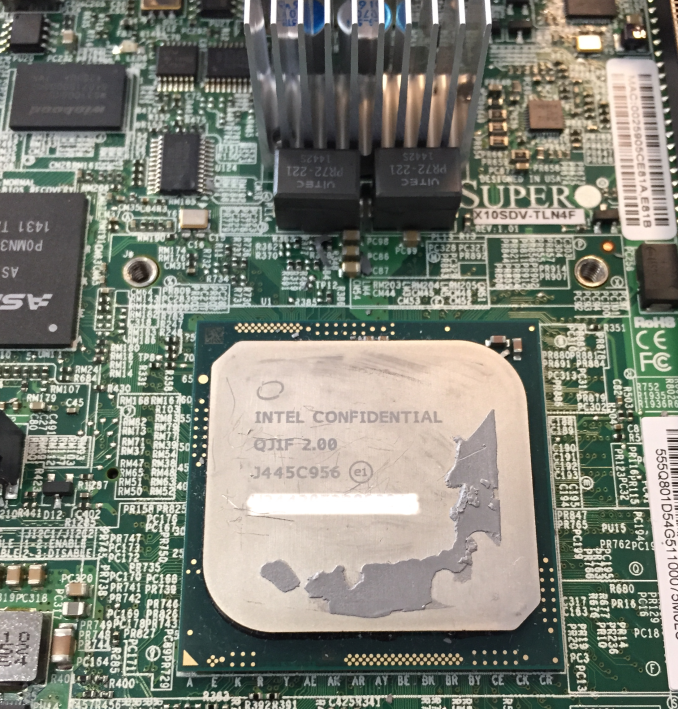The Intel Xeon D Review: Performance Per Watt Server SoC Champion?
by Johan De Gelas on June 23, 2015 8:35 AM EST- Posted in
- CPUs
- Intel
- Xeon-D
- Broadwell-DE

The days that Intel neglected the low end of the server market are over. The most affordable Xeon used to be the Xeon E3: a desktop CPU with a few server features enabled and with a lot of potential limitations unless you could afford the E5 Xeons. The gap, both in performance and price, between Xeon E3 and E5 is huge. For example - a Xeon E5 can address up to 768 GB and the Xeon E3 up to 32 GB. A Xeon E5 server could contain up to 36 cores, whereas Xeon E3 was limited to a paltry four. And the list is long: most RAS features, virtualization features were missing from the E3, along with a much smaller L3-cache. On those terms, the Xeon E3 simply did not feel very "pro".
Luckily, the customers in the ever expanding hyperscale market (Facebook, Amazon, Google, Rackspace and so on) need Xeons at a very large scale and have been demanding a better chip than the Xeon E3. Just a few months ago, the wait was over: Xeon D fills the gap between the Xeon E3 and the Xeon E5. Combining the most advanced 14 nm Broadwell cores, a dual 10 gigabit interface, a PCIe 3.0 root with 24 lanes, USB and SATA controllers in one integrated SoC, the Xeon D has excellent specs on paper for everyone who does not need the core count of the Xeon E5 servers, but who simply needs 'more' than the Xeon E3.
Many news editors could not resist calling the Xeon D a response to the ARM server threat. After all, ARM has repeated more than once that the ambition is to be competitive in the scale-out server market. The term "micro server" is hard to find on the power point slides these days; the "scale-out" market is a lot cooler, larger and more profitable. But the comments of the Facebook engineers can quickly brings us back to reality:
"Introducing "Yosemite": the first open source modular chassis for high-powered microservers"
"We started experimenting with SoCs about two years ago. At that time, the SoC products on the market were mostly lightweight, focusing on small cores and low power. Most of them were less than 30W. Our first approach was to pack up to 36 SoCs into a 2U enclosure, which could become up to 540 SoCs per rack. But that solution didn't work well because the single-thread performance was too low, resulting in higher latency for our web platform. Based on that experiment, we set our sights on higher-power processors while maintaining the modular SoC approach."
It is pretty simple: the whole "low power simple core" philosophy did not work very well in the real scale out (or "high powered micro server") market. And the reality is that the current SoCs with an ARM ISA do not deliver the necessary per core performance: they are still micro server SoCs, at best competing with the Atom C2750. So currently, there is no ARM SoC competition in the scale out market until something better hits the market for these big players.
Two questions remain: how much better is the 2 GHz Xeon D compared to the >3GHz Xeon E3? And is it an interesting alternative to those that do not need the high end Xeon E5?











90 Comments
View All Comments
julianb - Saturday, October 31, 2015 - link
Thanks for the reply, man.And sorry for my late reply, totally forgot about this thread :)
eva2000 - Tuesday, June 23, 2015 - link
Nice... Xeon D-1540 is awesome, but I wish it was clocked 0.2Ghz higher across the board would be just enough to tip that scale versus E5. Did my own benchmarks at https://community.centminmod.com/threads/2864/ :)extide - Wednesday, June 24, 2015 - link
Thats probably exactly why it ISNT clocked 0.2Ghz higher across the board ;)I'm sure Intel wants to see some space between this and E5.
boogerlad - Tuesday, June 23, 2015 - link
If this was marketed for the consumer market with the ability to overclock, this would outsell everything completely. This is what the enthusiast needs!!!Refuge - Tuesday, June 23, 2015 - link
I don't think this is going to do much of anything for an enthusiast.Unless they are interested in building a server for some experiment or project.
JohanAnandtech - Wednesday, June 24, 2015 - link
I still think the i7 59xx series is a better match for consumers: higher clocks and thus ST performance. The Xeon D most interesting features such as integrated 10 GBe and low power don't interest most performance consumers. Most people will have a hard time saturating a 1 GBe line and power savings are not a priority.tspacie - Wednesday, June 24, 2015 - link
Seems to tick all the boxes for a software development machine. Very good at compilation. Reasonably priced for the performance. Low power. ECC memory. I'm temptedextide - Wednesday, June 24, 2015 - link
EXACTLY what I was thinking!MrSpadge - Saturday, June 27, 2015 - link
I would be very tempted by such a chip as well, using it for BOINC. However, Broadwell looses some of the power efficiency advantage if you push it harder, i.e. the largest gains are at low and moderate frequency. Perfect for such server chips and mobile ones, but not so much for people aiming for 4+ GHz.MaxKreimerman - Tuesday, June 23, 2015 - link
Sounds impresive in just 45w package, but imposible to find in the retail sites such as newegg or wiredzone